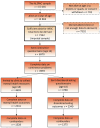Continence Problems and Mental Health in Adolescents from a UK Cohort
- PMID: 37248139
- PMCID: PMC7617164
- DOI: 10.1016/j.eururo.2023.05.013
Continence Problems and Mental Health in Adolescents from a UK Cohort
Abstract
Background: Adolescents with continence problems experience unique threats to their psychological well-being, but long-term mental health sequelae are unknown.
Objective: To examine prospective relationships between incontinence/lower urinary tract symptoms (LUTS) and mental health problems in young people.
Design, setting, and participants: A prospective cohort study of young people (n = 7332: 3639 males and 3693 females) from a population-based sample was conducted.
Outcome measurements and statistical analysis: We estimated the association between incontinence/LUTS and mental health outcomes using multivariable regression models adjusted for sex, socioeconomic position, developmental level, intelligence quotient, stressful life events, maternal psychopathology, body mass index, and emotional/behavioural problems.
Results and limitations: Daytime wetting and voiding postponement showed the greatest number of associations with mental health problems. All incontinence subtypes/LUTS were associated with increased odds of generalised anxiety disorder (eg, odds ratio for daytime wetting = 3.01, 95% confidence interval [1.78, 5.09], p < 0.001) and/or higher anxiety scores. There was also evidence of associations with common mental disorder (eg, voiding postponement: 1.88 [1.46, 2.41], p < 0.001), depression (eg, urgency: 1.94 [1.19, 3.14], p = 0.008), depressive symptoms (eg, daytime wetting: 1.70 [1.13, 2.56], p = 0.01), self-harm thoughts (eg, voiding postponement: 1.52 [1.16, 1.99], p = 0.003), and disordered eating (eg, nocturia 1.72 [1.27, 2.34], p = 0.001). We are unable to generalise our results to minority ethnic groups, less affluent populations, and non-UK samples.
Conclusions: Young people with incontinence/LUTS are at an increased risk of mental health problems. Further research is needed to establish the direction of causality.
Patient summary: We looked at the association between continence problems and mental health outcomes in young people from a large population-based cohort. Young people with continence problems at the age of 14 yr were more likely to suffer from a range of mental health problems at the age of 18 yr, including common mental disorder, depression, anxiety, self-harm thoughts, and disordered eating. Paediatric continence clinics should address the mental health needs of young people and provide clear and effective care pathways to child and adolescent mental health services.
Keywords: Adolescence; Avon Longitudinal Study of Parents and Children; Incontinence; Lower Urinary Tract Symptoms; Mental health; Prospective cohort.
Copyright © 2023 The Author(s). Published by Elsevier B.V. All rights reserved.
Conflict of interest statement
Figures
References
-
- von Gontard A, Cardozo L, Rantell A, Djurhuus JC. Adolescents with nocturnal enuresis and daytime urinary incontinence—how can pediatric and adult care be improved—ICI-RS 2015? Neurourol Urodyn. 2017;36:843–9. - PubMed
-
- Platt B, Cohen Kadosh K, Lau JY. The role of peer rejection in adolescent depression. Depress Anxiety. 2013;30:809–21. - PubMed
Publication types
MeSH terms
Grants and funding
LinkOut - more resources
Full Text Sources
Other Literature Sources
Medical


